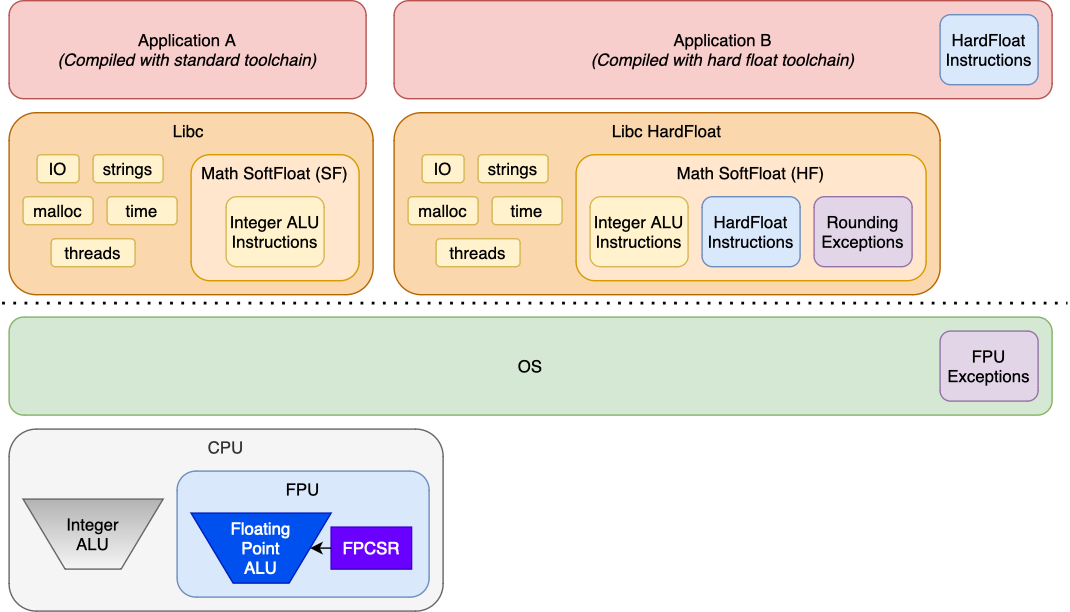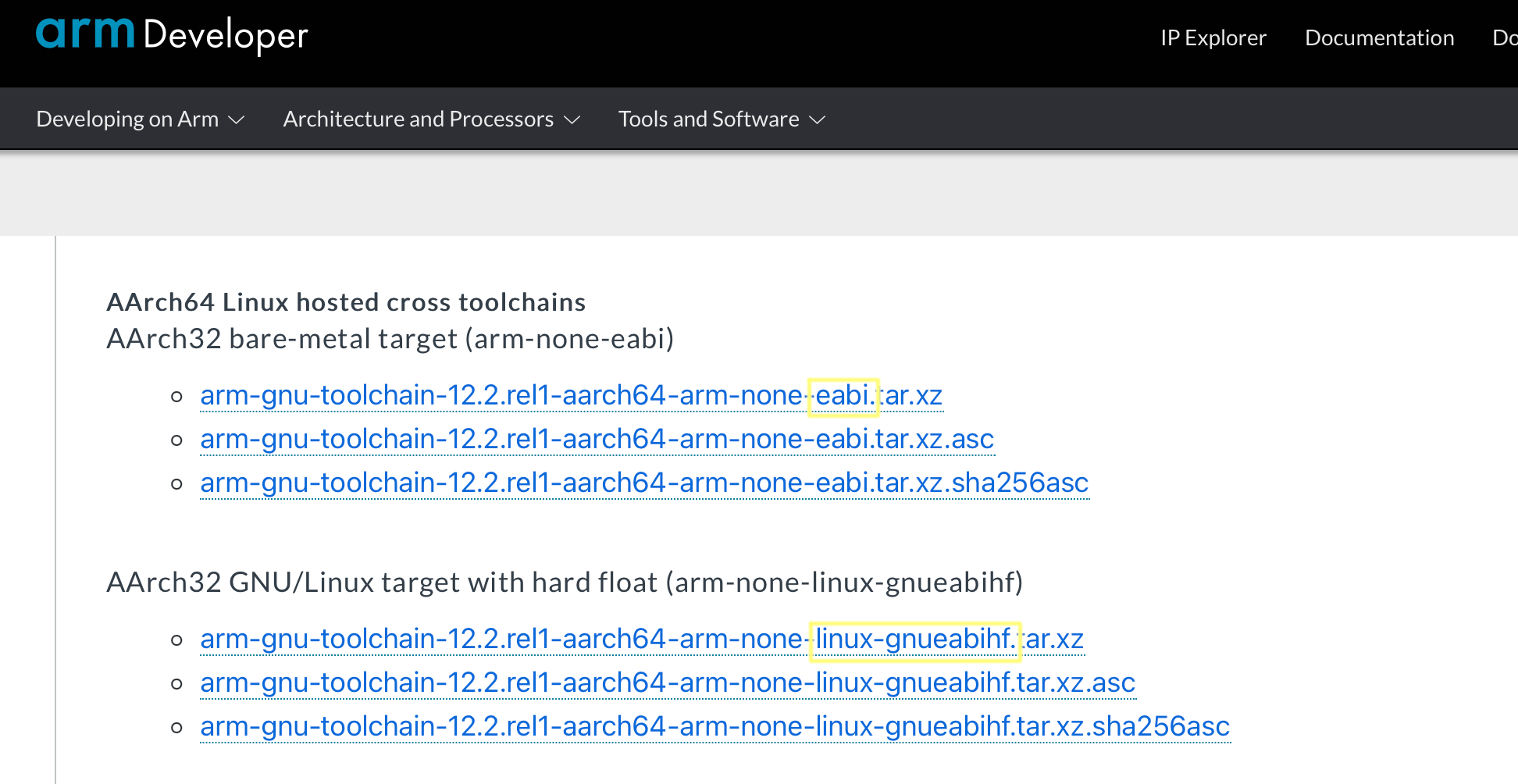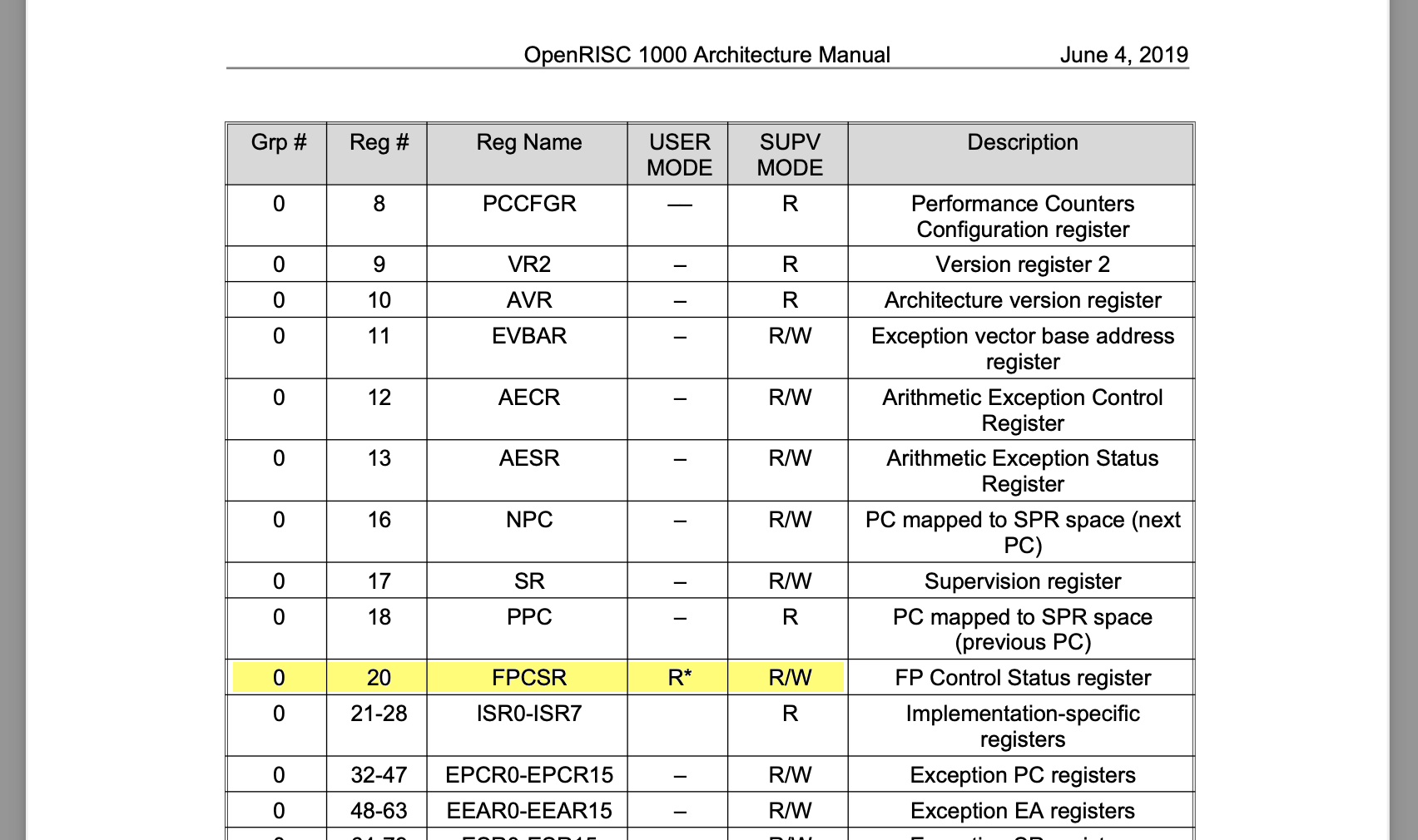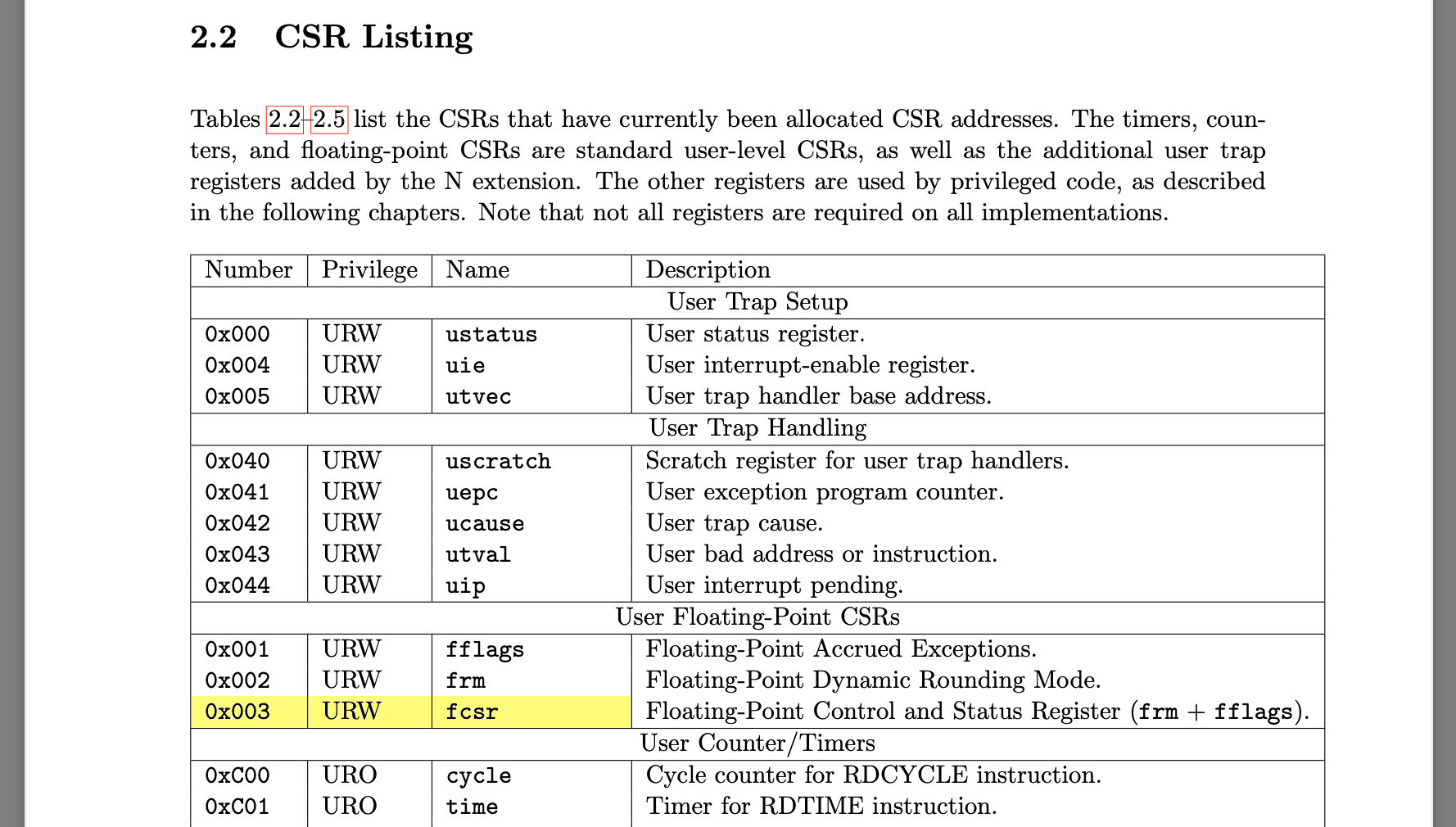Last year (2022) the big milestone for OpenRISC was getting the glibc port upstream. Though there is libc support for OpenRISC already with musl and ucLibc the glibc port provides a extensive testsuite which has proved useful in shaking out toolchain and OS bugs.
The upstreamed OpenRISC glibc support is missing support for leveraging the OpenRISC floating-point unit (FPU). Adding OpenRISC glibc FPU support requires a cross cutting effort across the architecture’s fullstack from:
- Architecture Specification
- Simulators and CPU implementations
- Linux Kernel support
- GCC Instructions and Soft FPU
- Binutils/GDB Debugging Support
- glibc support
In this blog entry I will cover how the OpenRISC architecture specification was updated to support user space floating point applications. But first, what is FPU porting?
What is FPU Porting?
The FPU in modern CPU’s allow the processor to perform IEEE 754
floating point math like addition, subtraction, multiplication. When used in a
user application the FPU’s function becomes more of a math accelerator, speeding
up math operations including
trigonometric and
complex functions such as sin,
sinf and cexpf. Not all FPU’s provide the same
set of FPU operations nor do they have to. When enabled, the compiler will
insert floating point instructions where they can be used.
OpenRISC FPU support was added to the GCC compiler a while back. We can see how this works with a simple example using the bare-metal newlib toolchain.
C code example addf.c:
float addf(float a, float b) {
return a + b;
}
To compile this C function we can do:
$ or1k-elf-gcc -O2 addf.c -c -o addf-sf.o
$ or1k-elf-gcc -O2 -mhard-float addf.c -c -o addf-hf.o
Assembly output of addf-sf.o contains the default software floating point
implementation as we can see below. We can see below that a call to __addsf3 was
added to perform our floating point operation. The function __addsf3
is provided
by libgcc as a software implementation of the single precision
floating point (sf) add operation.
$ or1k-elf-objdump -dr addf-sf.o
Disassembly of section .text:
00000000 <addf>:
0: 9c 21 ff fc l.addi r1,r1,-4
4: d4 01 48 00 l.sw 0(r1),r9
8: 04 00 00 00 l.jal 8 <addf+0x8>
8: R_OR1K_INSN_REL_26 __addsf3
c: 15 00 00 00 l.nop 0x0
10: 85 21 00 00 l.lwz r9,0(r1)
14: 44 00 48 00 l.jr r9
18: 9c 21 00 04 l.addi r1,r1,4
The disassembly of the addf-hf.o below shows that the FPU instruction
(hardware) lf.add.s is used to perform addition, this is because the snippet
was compiled using the -mhard-float argument. One could imagine if this is
supported it would be more efficient compared to the software implementation.
$ or1k-elf-objdump -dr addf-hf.o
Disassembly of section .text:
00000000 <addf>:
0: c9 63 20 00 lf.add.s r11,r3,r4
4: 44 00 48 00 l.jr r9
8: 15 00 00 00 l.nop 0x0
So if the OpenRISC toolchain already has support for FPU instructions what else needs to be done? When we add FPU support to glibc we are adding FPU support to the OpenRISC POSIX runtime and create a toolchain that can compile and link binaries to run on this runtime.
The Runtime
Below we can see examples of two application runtimes, one Application A runs with software floating point, the other Application B run’s with full hardware floating point.

Both Application A and Application B can run on the same system, but Application B requires a libc and kernel that support the floating point runtime. As we can see:
- In Application B it leverages floating point instructions as noted in the blue box. That should be implemented in the CPU, and are produced by the GCC compiler.
- The math routines in the C Library used by Application B are accelarated by the FPU as per the blue box. The math routines can also set up rounding of the FPU hardware to be in line with rounding of the software routines. The math routines can also detect exceptions by checking the FPU state. The rounding and exception handling in the purple boxes is what is implemented the GLIBC.
- The kernel must be able to save and restore the FPU state when switching between processes. The OS also has support for signalling the process if enabled. This is indicated in the purple box.
Another aspect is that supporting hardware floating point in the OS means that multiple user land programs can transparently use the FPU. To do all of this we need to update the kernel and the C runtime libraries to:
- Make the kernel save and restore process FPU state during context switches
- Make the kernel handle FPU exceptions and deliver signals to user land
- Teach GLIBC how to setup FPU rounding mode
- Teach GLIBC how to translate FPU exceptions
- Tell GCC and GLIBC soft float about our FPU quirks
The Toolchain
In order to compile applications like Application B a separate compiler toolchain is needed. For highly configurable embredded system CPU’s like ARM, RISC-V there are multiple toolchains available for building software for the different CPU configurations. Usually there will be one toolchain for soft float and one for hard float support, see the below example from the arm toolchain download page.

Fixing Architecture Issues
As we started to work on the floating point support we found two issues:
- The OpenRISC floating point control and status register (FPCSR) is accessible only in supervisor mode.
- We have not defined how the FPU should perform tininess detection.
FPCSR Access
The GLIBC OpenRISC FPU port, or any port for that matter, starts
by looking at what other architectures have done. For GLIBC FPU support we can
look at what MIPS, ARM, RISC-V etc. have implemented. Most ports have a file
called sysdeps/{arch}/fpu_control.h, I noticed one thing right away as I went
through this, we can look at ARM or MIPS for example:
sysdeps/mips/fpu_control.h: Excerpt from the MIPS port showing the definition of _FPU_GETCW and _FPU_SETCW
#else
# define _FPU_GETCW(cw) __asm__ volatile ("cfc1 %0,$31" : "=r" (cw))
# define _FPU_SETCW(cw) __asm__ volatile ("ctc1 %0,$31" : : "r" (cw))
#endif
sysdeps/arm/fpu_control.h: Excerpt from the ARM port showing the definition of _FPU_GETCW and _FPU_SETCW
# define _FPU_GETCW(cw) \
__asm__ __volatile__ ("vmrs %0, fpscr" : "=r" (cw))
# define _FPU_SETCW(cw) \
__asm__ __volatile__ ("vmsr fpscr, %0" : : "r" (cw))
#endif
What we see here is a macro that defines how to read or write the floating point control word for each architecture. The macros are implemented using a single assembly instruction.
In OpenRISC we have similar instructions for reading and writing the floating
point control register (FPCSR), writing for example is: l.mtspr r0,%0,20. However,
on OpenRISC the FPCSR is read-only when running in user-space, this is a
problem.
If we remember from our operating system studies, user applications run in user-mode as apposed to the privileged kernel-mode. The user floating point environment is defined by POSIX in the ISO C Standard. The C library provides functions to set rounding modes and clear exceptions using for example fesetround for setting FPU rounding modes and feholdexcept for clearing exceptions. If userspace applications need to be able to control the floating point unit the having architectures support for this is integral.
Originally OpenRISC architecture specification specified the floating point control and status registers (FPCSR) as being read only when executing in user mode, again this is a problem and needs to be addressed.

Other architectures define the floating point control register as being writable in user-mode. For example, ARM has the FPCR and FPSR, and RISC-V has the FCSR all of which are writable in user-mode.

Tininess Detection
I am skipping ahead a bit here, once the OpenRISC GLIBC port was working we noticed many problematic math test failures. This turned out to be inconsistencies between the tininess detection [pdf] settings in the toolchain. Tininess detection must be selected by an FPU implementation as being done before or after rounding. In the toolchain this is configured by:
- GLIBC
TININESS_AFTER_ROUNDING- macro used by test suite to control expectations - GLIBC
_FP_TININESS_AFTER_ROUNDING- macro used to control softfloat implementation in GLIBC. - GCC libgcc
_FP_TININESS_AFTER_ROUNDING- macro used to control softfloat implementation in GCC libgcc.
Updating the Spec
Writing to FPCSR from user-mode could be worked around in OpenRISC by introducing a syscall, but we decided to just change the architecture specification for this. Updating the spec keeps it similar to all other architectures out there.
In OpenRISC we have defined tininess detection to be done before rounding as this matches what existing FPU implementation have done.
As of architecture specification revision 1.4 the FPCSR is defined as being writable in user-mode and we have documented tininess detection to be before rounding.
Summary
We’ve gone through an overview of how the FPU accelarates math in an application runtime. We then looked how the OpenRISC architecture specification needed to be updated to support the floating point POSIX runtime.
In the next entry we shall look into patches to get QEMU and and CPU implementations updated to support the new spec changes.